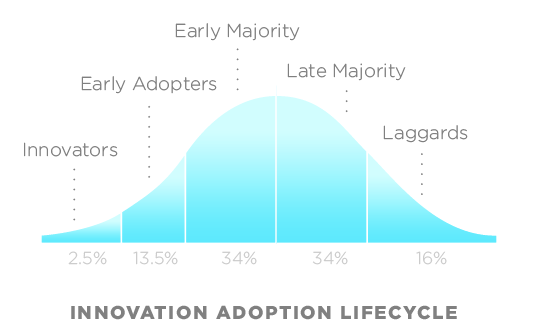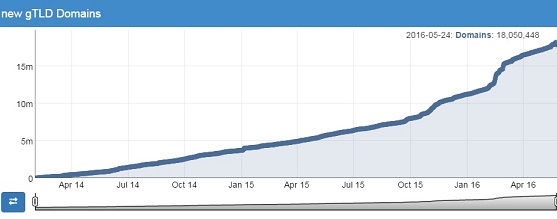Innovation
Posted by Daniel Negari in Featured, gTLDs

Source: https://upload.wikimedia.org/wikipedia/en/4/45/DiffusionOfInnovation.png
I remember back at USC one of my Entrepreneur professors shared the above graph of the Innovation Adoption Lifecycle. The model shows how new technology is adopted over time. This can be applied to many products and services. Back then, I thought, “Innovators and early adopters? What is all this?” Fast forward to today, being the CEO of a highly innovative product in .xyz, I believe new gTLDs are at the very early stage of the Innovator phase of the above graph.
It is obvious to me that right now, only a few years into the new generic top level domain (gTLD) lifecycle, that innovators are using new gTLDs as a whole. In my opinion, we aren’t even at 1% yet. The average internet user is still not aware that new gTLDs even exist and there are only a handful of innovators that are actually registering and using new gTLDs (ex: https://gen.xyz/live).
Today, there are just over 18 million new gTLD domains that have been registered:

Over the course of about 2 years, we can see that new gTLD registrations have gained momentum. I find it promising that we have so much traction already.
Assuming I am correct in stating that we are at 1% of the new gTLD lifecycle, we can reasonably expect 1,800,000,000 domain names to be registered during the entire lifecycle. Yes – 1.8 BILLION new gTLD domains (my math: 18,000,000 current domains/.01)!
Let’s assume that I am off by 50%. There would still be 900 million new gTLD domains, which is more than 2 times the total number of domains registered today in all gTLDs and country code top level domains (ccTLDs).
So how will the introduction of new gTLD domains affect the registration volume of legacy TLDs? I believe that legacy TLDs like .com, .net, .org, biz, .info and ccTLDs will actually benefit from the vast domain options that now exist in the marketplace. From my experience, a rising tide lifts all boats.
New gTLDs provide a greater level of choice and accessibility for internet users worldwide – many of which are establishing websites for the first time. As registrars continue to improve the domain checkout process and make it easier for consumers to build websites, we will see the usage of domains grow as well. I have consistently said that there will be billions of domains in use in our lifetimes. As time goes on, more internet users – especially those in developing countries – will be coming online, and they will need an online identity.
A parallel can be drawn here to the IP address system used in computer networking. An IP address is a unique number assigned to each device (ex: computer or printer) in a computer network. The IPv4 networking method, which uses 32-bit addresses, was first introduced in the 1980s (ex: 172.16.254.1). There are a total of 4,294,967,296 (~4.3 billion) unique IPv4 values. At the time, the creators of IPv4 thought that the internet would never run out of IP addresses (source: https://youtu.be/-Uwjt32NvVA?t=23s). Well, fast forward to 2016 and there are more connected devices than there are IPv4 addresses. That’s right, we RAN OUT of 4 billion+ IPv4 addresses because now there are BILLIONS of devices that need an address, including computers, mobile devices, printers, routers, etc…
Luckily, in 1996 the Internet Engineering Task Force (IETF) had the foresight to introduce a new 128-bit format for IP addresses (IPv6), which allowed for 3.4×10^38 (340 trillion trillion trillion) unique addresses. An example of an IPv6 address is 2001:0db8:0000:0042:0000:8a2e:0370:7334. On June 6, 2012 Google and others finally turned on IPv6 capability and launched the new, larger internet.

As you can see, the US now has over 25% IPv6 adoption (for Google users). However, a majority of countries are lagging behind. It appears that we are still in the Early Adopter phase of the IPv6 lifecycle, with about 11% of worldwide Google users with IPv6 connectivity (source: https://www.google.com/intl/en/ipv6/statistics.html#tab=ipv6-adoption&tab=ipv6-adoption).
Keep in mind IPv6 was set up in 1996. The Innovation Adoption Lifecycle takes time. But each time a new innovation is introduced, it takes less and less time for it to be picked up. I am confident that new gTLDs are on a real fast track to success.
As billions more connected devices come into existence this century, many devices will be handheld (ex: mobile phones, tablets, VR, augmented reality, etc…). Internet users prefer shorter domain names (source: http://www.gaebler.com/Domain-Length-Research.htm), and new gTLDs create trillions of new options. The purpose of domain names is to make it easier for internet users to get to their destination. As more IP addresses get registered, domains become even more important. Could you imagine trying to type “2001:0db8:0000:0042:0000:8a2e:0370:7334” into your browser to get to a website? What is easier to remember: “CEO.xyz” or “2001:0db8:0000:0042:0000:8a2e:0370:7334?” New gTLD options like .xyz and .rent give internet users the ability to easily navigate to a memorable online location.
No doubt this is the future.
The Innovation Adoption Lifecycle is a model that I believe will hold true in the new gTLD space. As a result, XYZ will continue to drive the new gTLD lifecycle forward in order to provide innovation and choice to the growing number of internet users worldwide.
Cheers to 2 years of .xyz and billions more domains to come.
#GenXYZ
D







took ilove.xyz days before.
believe it is the next .com and I love it.